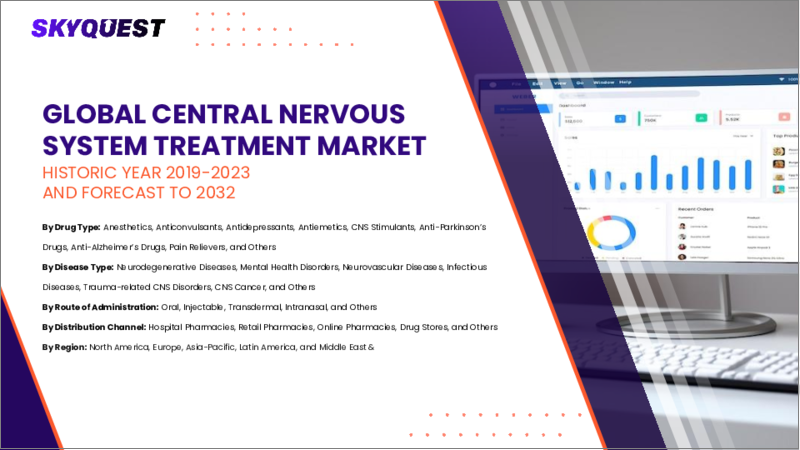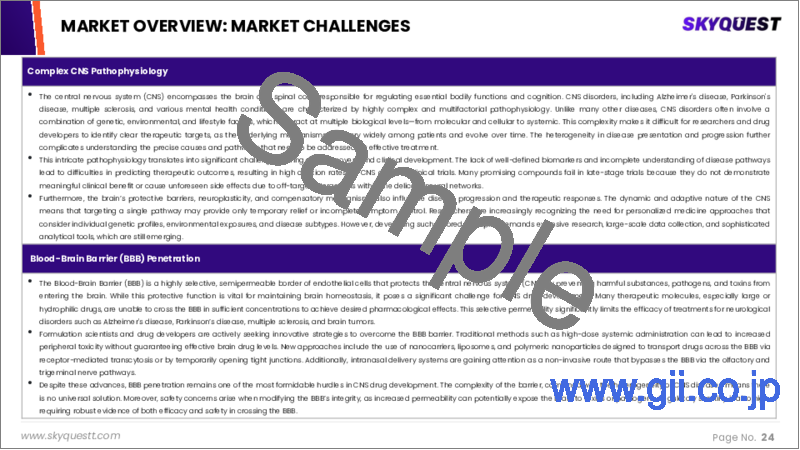|
|
市場調査レポート
商品コード
1630630
中枢神経系治療市場規模、シェア、成長分析、疾患タイプ別、薬剤のタイプ別、薬剤のクラス別、流通チャネル別、地域別 - 産業予測、2025-2032年Central Nervous System Treatment Market Size, Share, Growth Analysis, By Disease Type, By Drug Type, By Drug Class, By Distribution Channel, By Region - Industry Forecast 2025-2032 |
||||||
|
|||||||
| 中枢神経系治療市場規模、シェア、成長分析、疾患タイプ別、薬剤のタイプ別、薬剤のクラス別、流通チャネル別、地域別 - 産業予測、2025-2032年 |
|
出版日: 2025年01月07日
発行: SkyQuest
ページ情報: 英文 260 Pages
納期: 3~5営業日
|
全表示
- 概要
- 目次
中枢神経系治療の世界市場規模は、2023年に1,282億9,000万米ドルと評価され、2024年の1,363億7,000万米ドルから2032年には2,223億3,000万米ドルに成長し、予測期間(2025年~2032年)のCAGRは6.3%で成長する見通しです。
座りがちで多忙なライフスタイルの世界の増加により、統合失調症やアルツハイマー病などの慢性疾患や中枢神経系(CNS)疾患が急増しています。この動向により、脳神経外科医、神経科医、理学療法士を含む集学的治療アプローチが必要となり、包括的な患者ケアのための協力体制が育まれています。神経科学における継続的な進歩は、外科的技術、遺伝子治療、神経画像技術を含む革新的な治療の開発を推進しています。世界保健機関(WHO)の報告によると、世界中で10億人以上の患者が罹患しており、製薬会社は満たされていない重大な医療ニーズに応えるため、新たな中枢神経系治療薬に投資することで対応しています。さらに、ジェネリック医薬品の利用が可能になったことで、特に中低所得国での治療アクセスが向上し、中枢神経系治療薬の市場成長と競争激化が期待されています。
目次
イントロダクション
- 調査の目的
- 調査範囲
- 定義
調査手法
- 情報調達
- 二次データと一次データの方法
- 市場規模予測
- 市場の前提条件と制限
エグゼクティブサマリー
- 世界市場の見通し
- 供給と需要の動向分析
- セグメント別機会分析
市場力学と見通し
- 市場概要
- 市場規模
- 市場力学
- 促進要因と機会
- 抑制要因と課題
- ポーターの分析
主な市場の考察
- 重要成功要因
- 競合の程度
- 主な投資機会
- 市場エコシステム
- 市場の魅力指数(2024年)
- PESTEL分析
- マクロ経済指標
- バリューチェーン分析
- 価格分析
中枢神経系治療市場規模:疾患タイプ別
- 市場概要
- 神経血管疾患
- 出血性脳卒中
- 虚血性脳卒中
- その他
- 神経変性疾患
- アルツハイマー病
- パーキンソン病
- 多発性硬化症
- その他
- メンタルヘルス
- てんかん
- 気分障害
- 不安障害
- その他
- 感染症
- 髄膜炎
- 脳炎
- その他
- その他
中枢神経系治療市場規模:薬剤のタイプ別
- 市場概要
- 生物学的製剤
- 非生物製剤
中枢神経系治療市場規模:薬剤のクラス別
- 市場概要
- 免疫調節薬
- インターフェロン
- 脱炭酸酵素阻害剤
- ドーパミン作動薬
- 抗うつ薬
- 鎮痛剤
- その他
中枢神経系治療市場規模:流通チャネル別
- 市場概要
- 病院薬局
- 小売薬局
- オンライン薬局
中枢神経系治療市場規模
- 北米
- 米国
- カナダ
- 欧州
- ドイツ
- スペイン
- フランス
- 英国
- イタリア
- その他欧州地域
- アジア太平洋地域
- 中国
- インド
- 日本
- 韓国
- その他アジア太平洋地域
- ラテンアメリカ
- ブラジル
- その他ラテンアメリカ地域
- 中東・アフリカ
- GCC諸国
- 南アフリカ
- その他中東・アフリカ
競合情報
- 上位5社の比較
- 主要企業の市場ポジショニング(2024年)
- 主な市場企業が採用した戦略
- 市場の最近の動向
- 企業の市場シェア分析(2024年)
- 主要企業の企業プロファイル
- 会社概要
- 製品ポートフォリオ分析
- セグメント別シェア分析
- 収益の前年比比較(2022-2024)
主要企業プロファイル
- Biogen Inc.(United States)
- Johnson & Johnson(United States)
- Novartis AG(Switzerland)
- UCB S.A.(Belgium)
- Takeda Pharmaceutical Company Ltd.(Japan)
- Pfizer Inc.(United States)
- Roche Holding AG(Switzerland)
- Sanofi S.A.(France)
- Eli Lilly and Company(United States)
- Otsuka Holdings Co., Ltd.(Japan)
- Lundbeck A/S(Denmark)
- GlaxoSmithKline plc(GSK)(United Kingdom)
- AstraZeneca plc(United Kingdom)
- Merck & Co., Inc.(United States)
- Bristol-Myers Squibb Company(United States)
- Amgen Inc.(United States)
- Teva Pharmaceutical Industries Ltd.(Israel)
- AbbVie Inc.(United States)
- Allergan plc(Ireland)
- Shionogi & Co., Ltd.(Japan)
結論と推奨事項
Global Central Nervous System Treatment Market size was valued at USD 128.29 billion in 2023 and is poised to grow from USD 136.37 billion in 2024 to USD 222.33 billion by 2032, growing at a CAGR of 6.3% during the forecast period (2025-2032).
The global rise in sedentary and hectic lifestyles has resulted in a surge of chronic and central nervous system (CNS) disorders, such as schizophrenia and Alzheimer's disease. This trend has necessitated a multidisciplinary treatment approach involving neurosurgeons, neurologists, and physical therapists, fostering collaboration for comprehensive patient care. Ongoing advancements in neuroscience are driving the development of innovative treatments, including surgical techniques, gene therapies, and neuroimaging technologies. As the World Health Organization reports over 1 billion affected individuals worldwide, pharmaceutical companies are responding by investing in new CNS therapies to address significant unmet medical needs. Additionally, the availability of generic medications is enhancing treatment access, particularly in low- and middle-income countries, promising market growth and increased competition in CNS therapeutics.
Top-down and bottom-up approaches were used to estimate and validate the size of the Global Central Nervous System Treatment market and to estimate the size of various other dependent submarkets. The research methodology used to estimate the market size includes the following details: The key players in the market were identified through secondary research, and their market shares in the respective regions were determined through primary and secondary research. This entire procedure includes the study of the annual and financial reports of the top market players and extensive interviews for key insights from industry leaders such as CEOs, VPs, directors, and marketing executives. All percentage shares split, and breakdowns were determined using secondary sources and verified through Primary sources. All possible parameters that affect the markets covered in this research study have been accounted for, viewed in extensive detail, verified through primary research, and analyzed to get the final quantitative and qualitative data.
Global Central Nervous System Treatment Market Segmental Analysis
Global Central Nervous System Treatment Market is segmented by Disease Type, Drug Type, Drug Class, Distribution Channel and region. Based on Disease Type, the market is segmented into Neurovascular Diseases, Neurodegenerative Diseases, Mental Health, Infectious Diseases and Others. Based on Drug Type, the market is segmented into Biologics and Non-biologics. Based on Drug Class, the market is segmented into Immunomodulatory Drugs, Interferons, Decarboxylase Inhibitors, Dopamine Agonists, Antidepressants, Analgesics and Others. Based on Distribution Channel, the market is segmented into Hospital Pharmacies, Retail Pharmacies and Online Pharmacies. Based on region, the market is segmented into North America, Europe, Asia Pacific, Latin America and Middle East & Africa.
Driver of the Global Central Nervous System Treatment Market
The Global Central Nervous System Treatment market is being propelled by a notable increase in the incidence of mental health disorders and significant advancements in pipeline research. The rising global prevalence of neurological conditions such as multiple sclerosis, Alzheimer's disease, and Parkinson's disease is a major factor in driving market expansion. Additionally, the aging population in many regions is contributing to the surge in Alzheimer's cases; the Alzheimer's Association reports over five million individuals currently affected, with projections reaching 14 million by 2050. Furthermore, the potential launch of new treatments for these conditions is expected to enhance healthcare access in developing nations, exemplified by Corbus Pharmaceuticals' ongoing Phase 3 clinical trial of Lenabasum for diffuse cutaneous systemic sclerosis. This combination of rising disease prevalence and innovative treatment options creates a robust foundation for growth in the sector.
Restraints in the Global Central Nervous System Treatment Market
The Global Central Nervous System Treatment market faces significant restraints primarily due to the high costs associated with drug development and complex regulatory requirements. Investment in research and development for therapies targeting CNS disorders is notably higher compared to other therapeutic areas. The specialized nature of CNS treatments mandates a high level of precision, but there is a scarcity of qualified medical professionals to conduct such work. Additionally, the lengthy drug approval process, which can span several years, complicates the timeline for bringing CNS drugs to market. Insufficient understanding of neuroscience may hinder timely approvals and delay the introduction of effective treatments for CNS disorders.
Market Trends of the Global Central Nervous System Treatment Market
The Global Central Nervous System (CNS) Treatment market is experiencing robust growth, driven by increasing investments in neuroscience research, drug development, and innovative therapeutic solutions. Rising incidences of neurological disorders such as Alzheimer's, Parkinson's, and multiple sclerosis are propelling demand for more effective treatments. Additionally, advancements in technology, including neuroimaging and biomarker discovery, are providing new avenues for targeted therapies. Key market players are collaborating with biotech firms and academia to accelerate the development of personalized medicine. The market is also witnessing a surge in funding from governmental and private sectors aimed at enhancing CNS treatment options, forecasting significant expansion through the coming years.
Table of Contents
Introduction
- Objectives of the Study
- Scope of the Report
- Definitions
Research Methodology
- Information Procurement
- Secondary & Primary Data Methods
- Market Size Estimation
- Market Assumptions & Limitations
Executive Summary
- Global Market Outlook
- Supply & Demand Trend Analysis
- Segmental Opportunity Analysis
Market Dynamics & Outlook
- Market Overview
- Market Size
- Market Dynamics
- Drivers & Opportunities
- Restraints & Challenges
- Porters Analysis
- Competitive rivalry
- Threat of substitute
- Bargaining power of buyers
- Threat of new entrants
- Bargaining power of suppliers
Key Market Insights
- Key Success Factors
- Degree of Competition
- Top Investment Pockets
- Market Ecosystem
- Market Attractiveness Index, 2024
- PESTEL Analysis
- Macro-Economic Indicators
- Value Chain Analysis
- Pricing Analysis
Global Central Nervous System Treatment Market Size by Disease Type & CAGR (2025-2032)
- Market Overview
- Neurovascular Diseases
- Hemorrhagic Stroke
- Ischemic Stroke
- Others
- Neurodegenerative Diseases
- Alzheimer's Disease
- Parkinson's Disease
- Multiple Sclerosis
- Others
- Mental Health
- Epilepsy
- Mood Disorders
- Anxiety Disorders
- Others
- Infectious Diseases
- Meningitis
- Encephalitis
- Others
- Others
Global Central Nervous System Treatment Market Size by Drug Type & CAGR (2025-2032)
- Market Overview
- Biologics
- Non-biologics
Global Central Nervous System Treatment Market Size by Drug Class & CAGR (2025-2032)
- Market Overview
- Immunomodulatory Drugs
- Interferons
- Decarboxylase Inhibitors
- Dopamine Agonists
- Antidepressants
- Analgesics
- Others
Global Central Nervous System Treatment Market Size by Distribution Channel & CAGR (2025-2032)
- Market Overview
- Hospital Pharmacies
- Retail Pharmacies
- Online Pharmacies
Global Central Nervous System Treatment Market Size & CAGR (2025-2032)
- North America (Disease Type, Drug Type, Drug Class, Distribution Channel)
- US
- Canada
- Europe (Disease Type, Drug Type, Drug Class, Distribution Channel)
- Germany
- Spain
- France
- UK
- Italy
- Rest of Europe
- Asia Pacific (Disease Type, Drug Type, Drug Class, Distribution Channel)
- China
- India
- Japan
- South Korea
- Rest of Asia-Pacific
- Latin America (Disease Type, Drug Type, Drug Class, Distribution Channel)
- Brazil
- Rest of Latin America
- Middle East & Africa (Disease Type, Drug Type, Drug Class, Distribution Channel)
- GCC Countries
- South Africa
- Rest of Middle East & Africa
Competitive Intelligence
- Top 5 Player Comparison
- Market Positioning of Key Players, 2024
- Strategies Adopted by Key Market Players
- Recent Developments in the Market
- Company Market Share Analysis, 2024
- Company Profiles of All Key Players
- Company Details
- Product Portfolio Analysis
- Company's Segmental Share Analysis
- Revenue Y-O-Y Comparison (2022-2024)
Key Company Profiles
- Biogen Inc. (United States)
- Company Overview
- Business Segment Overview
- Financial Updates
- Key Developments
- Johnson & Johnson (United States)
- Company Overview
- Business Segment Overview
- Financial Updates
- Key Developments
- Novartis AG (Switzerland)
- Company Overview
- Business Segment Overview
- Financial Updates
- Key Developments
- UCB S.A. (Belgium)
- Company Overview
- Business Segment Overview
- Financial Updates
- Key Developments
- Takeda Pharmaceutical Company Ltd. (Japan)
- Company Overview
- Business Segment Overview
- Financial Updates
- Key Developments
- Pfizer Inc. (United States)
- Company Overview
- Business Segment Overview
- Financial Updates
- Key Developments
- Roche Holding AG (Switzerland)
- Company Overview
- Business Segment Overview
- Financial Updates
- Key Developments
- Sanofi S.A. (France)
- Company Overview
- Business Segment Overview
- Financial Updates
- Key Developments
- Eli Lilly and Company (United States)
- Company Overview
- Business Segment Overview
- Financial Updates
- Key Developments
- Otsuka Holdings Co., Ltd. (Japan)
- Company Overview
- Business Segment Overview
- Financial Updates
- Key Developments
- Lundbeck A/S (Denmark)
- Company Overview
- Business Segment Overview
- Financial Updates
- Key Developments
- GlaxoSmithKline plc (GSK) (United Kingdom)
- Company Overview
- Business Segment Overview
- Financial Updates
- Key Developments
- AstraZeneca plc (United Kingdom)
- Company Overview
- Business Segment Overview
- Financial Updates
- Key Developments
- Merck & Co., Inc. (United States)
- Company Overview
- Business Segment Overview
- Financial Updates
- Key Developments
- Bristol-Myers Squibb Company (United States)
- Company Overview
- Business Segment Overview
- Financial Updates
- Key Developments
- Amgen Inc. (United States)
- Company Overview
- Business Segment Overview
- Financial Updates
- Key Developments
- Teva Pharmaceutical Industries Ltd. (Israel)
- Company Overview
- Business Segment Overview
- Financial Updates
- Key Developments
- AbbVie Inc. (United States)
- Company Overview
- Business Segment Overview
- Financial Updates
- Key Developments
- Allergan plc (Ireland)
- Company Overview
- Business Segment Overview
- Financial Updates
- Key Developments
- Shionogi & Co., Ltd. (Japan)
- Company Overview
- Business Segment Overview
- Financial Updates
- Key Developments





